|
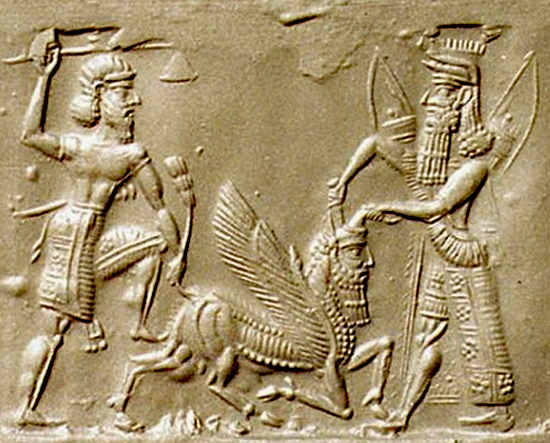
Gilgamesh Cylinder Seal Impression
Photo:
Tom Jensen. The Schoyen Collection.
Gilgamesh (around 2700/2600 BC)
Gilgamesh lived sometime around 2700
to 2600 BC and was the king of Uruk, a
What Does the Name
Gilgamesh Mean?
Ten people, ten opinions.
Let's say Gilgamesh
means The Old One Who is Youthful because
Maureen Kovacs thinks this might
be the case. And this lady's opinion scores higher than yours unless
you are also able to provide us with a translation of the Gilgamesh
Epic.
Here you can
 read Kovacs' English translation of the
Epic of Gilgamesh.
read Kovacs' English translation of the
Epic of Gilgamesh.
Gilgamesh's Family
According to legend, Gilgamesh's
father was Lugalbanda, a mortal.
His mother was divine. Her name was
Ninsun.
Apparently, this made Gilgamesh
one-third human and two-thirds divine. Welcome to
Babylonian mythology.
About the Image
at the Top of
This Page
Gilgamesh Cylinder Seal
Impression.
Illustrated is the scene during
which Gilgamesh and Enkidu are slaying the Bull of Heaven.
The good people at The
Schoyen Collection tell us:
Enkidu is wearing a short kilt
decorated with rosettes, hair and beard in curls, an axe in
one hand, holding the tail of the Bull of Heaven in the
other, the winged human-headed bull crouches down on its
foreleg, in front Gilgamesh, wearing long fringed robe with
rosettes, a double horned headdress, long curled hair and
beard, holding one of the bull's horns while plunging his
sword into its neck.
And here is a picture of the
Gilgamesh cylinder seal:
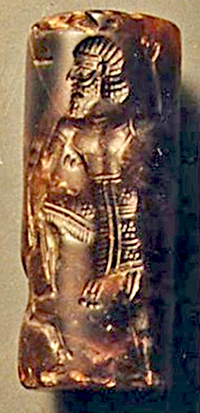
Gilgamesh
Cylinder Seal
Height: 3.9 cm, or 1.54
in; Diameter: 1.6 cm, or 0.63 in
Photo: Tom Jensen. The
Schoyen Collection.
This piece is one of five
surviving cylinder seals with this motive. Neo-Assyrian
style on brown agate. Made in Assyria, around the 7th
century BC.
Here is the full view of the photo
above:
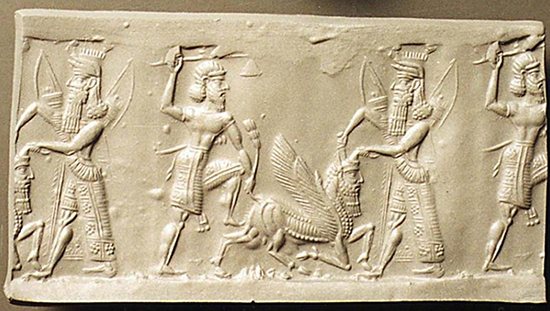
Gilgamesh Cylinder Seal Impression
Photo:
Tom Jensen. The Schoyen Collection.
Uruk —
City of Gilgamesh and Ishtar
Uruk, also called Erech, was the
metropolis of ancient Mesopotamia.
Ishtar, also called
Inanna, was the goddess of choice. And rightly so, as
she was responsible for love, sex, and war. Veneration also
went to Anu, also called
An, the god of the sky. The third
most important god was Ea, also called
Enki, the god of
water.
The city of Uruk had solid city
walls that run 6 miles or 10 kilometers long and which, so
it is said, were built by Gilgamesh himself.
Uruk is today's
Warka in
southeastern Iraq,
located approx. 300 kilometers south from Baghdad. Here is a photograph from the
city ruins at Warka:
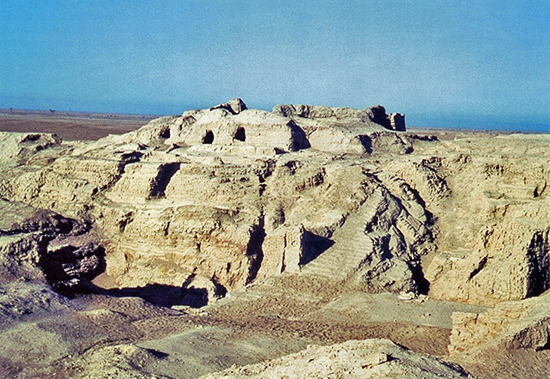
Ruins of Uruk
— The New York of Ancient Mesopotamia
Deutsche Orient-Gesellschaft
One
of the oldest cities ever, the ruins of Uruk cover an area of 550
ha, or 5.5 square kilometers, or 2.1 square miles. Back in
the days, the Euphrates River supplied the city with water.
The Euphrates since has changed its course and runs now 20 kilometers or 12
miles further to the west.
Here is a sketch of downtown Uruk, back in the days. Areas of the city had
monumental mud brick platforms and temple buildings.
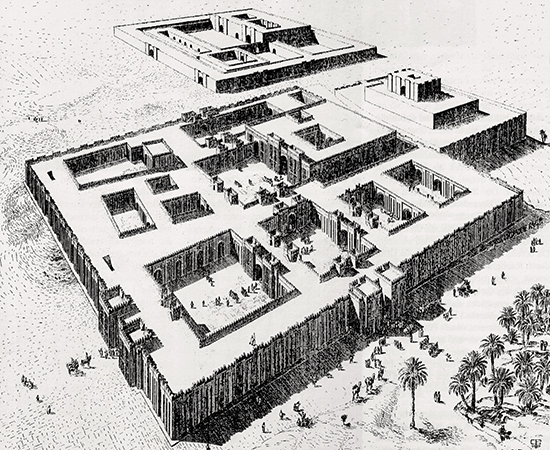
Massive
Buildings at Uruk
Deutsche Orient-Gesellschaft
And here is ancient Uruk on a map:

Map Location of
Uruk in Ancient Sumer / Ancient Mesopotamia
Click map to enlarge
The Gilgamesh Epic
Why Do the Gilgamesh
Poems Qualify as an Epic?
A.R. George at Cambridge University
tells us:
The name
Epic of Gilgamesh is given to the
Babylonian poem that tells the deeds of
Gilgamesh, the greatest king and mightiest
hero of ancient Mesopotamian legend.
The poem falls
into the category 'epic' because it is a
long narrative poem of heroic content and
has the seriousness and pathos that have
sometimes been identified as markers of epic.
There we have it.
When Was the Gilgamesh
Epic Composed?
Recording of the Epic probably
already begun during Gilgamesh's lifetime. By 2100 BC, the tale was huge,
both, in length and distribution.
Length:
The Gilgamesh
Epic is the longest piece
of literature in the Akkadian dialect (the language of
Babylonia and Assyria.)
"In its complete
state the Epic comprises about 2,900 lines
written on eleven clay tablets." (Kovacs)
Distribution:
Tales of
Gilgamesh circulated in abundance and in
translation.
What all did
the archaeologists find? And where?
The Gilgamesh
Epic and Archaeology
In Akkadian:
It was
Assyrian king Ashurbanipal, who kept the
largest archaeological record in existence
under his roof. Twelve tablets that contain
the Gilgamesh Epic were found in his
personal collection at his palace in
Nineveh.
King
Ashurbanipal ruled Assyria 668-627 BC, or 669 to 631
BC, depending on whom you ask.
Go here fore
more about
 King Ashurbanipal.
King Ashurbanipal.
Ashurbanipal's library contained thousands
of cuneiform tablets - letters, legal texts,
texts regarding science, and, of course,
mythology.
Now, about
these tablets.
Unfortunately,
the tablets are incomplete. But because the tale was widespread, the
incomplete parts could be filled by fragments that were found in other locations.
This Nineveh version
of the Epic has
been found all across Mesopotamia, in Palestine,
in Syria, and today's Turkey. It was
even used in schools as writing exercise.
In Sumerian:
Another set of tablets were found in the
Sumerian language, written during the first half of the second
millennium BC. This
Old Babylonian version lacks the prologue and
the famous flood
story.
These
tablets have five short
poems and are titled:
Gilgamesh and Huwawa
Gilgamesh and the Bull
of Heaven
Gilgamesh and Agga of Kish
Gilgamesh, Enkidu, and the
Netherworld
The
Death of Gilgamesh
Kovacs tells us:
The tablets
from Nineveh and Babylon are now in the
British Museum and provide the bulk of the
text. But many other fragments are
discovered since then.
The tablets so
far recovered represent some eight to twelve
copies of the Epic, most found in the palace
and temple libraries at Nineveh.
The Gilgamesh Epic in a Nutshell
Gilgamesh ruled harshly
and the people cried to the gods for help. The gods
replied by creating Enkidu, who was to challenge
Gilgamesh. Enkidu was created part animal, part human,
just to change things up a bit.
Enkidu met
Gilgamesh at Uruk,
where the two had a wrestling contest. Gilgamesh
won, but only by a narrow margin. Gilgamesh and
Enkidu realized
they weren't that different after all, and
became best friends forever.
Hanging out together was fun, but both guys
felt that eternal fame would be so much
sweeter. And off they went to cut down the
Sacred Cedars, which would bring them instant
stardom.
However, this
meant that they had to overcome Huwawa (Humbaba)
first. Huwawa was the divinely appointed guardian of the
Sacred
Cedar Forest, and a giant not by coincidence.
The giant was
beheaded, the cedars were cut, and Gilgamesh and Enkidu
shuffled back home to Uruk.
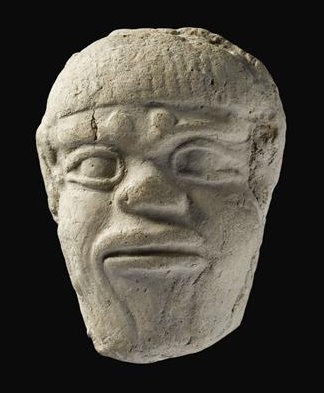
Mask of the demon Humbaba, whose "mouth is fire
and breath death."
Images of this
figure were used as lucky charms.
Sukkalmah Dynasty, early 2nd millennium BC.
Susa, Iran. Terra-cotta.
Excavations led by Roland de Mecquenem, 1927
© Photo RMN
/ F. Raux. Louvre, Paris.
The next challenge presented itself when
Ishtar, the goddess of love and war, ambushed
Gilgamesh with a marriage proposal. Gilgamesh
declined.
Ishtar snapped and sent the Bull of Heaven to
destroy everything in and around Uruk.
The Bull killed
hundreds of young men from the city, until it
encountered Gilgamesh and Enkidu. Enkidu grabbed
the Bull's tale, Gilgamesh put his sword into
the Bull's neck, and that was the end of the
Bull.
The episode with
the slaying of the Bull of Heaven is
treated in tablet VI:
"Gilgamesh, like an
able slaughterer, strikes with his sword the
Bull of Heaven forcefully and precisely
between shoulders and neck."
This adventure
became quite famous and the motive for many artistic renderings (see
image at top of the page.)
Taking a slightly darker turn, the tale now
describes how
Enkidu had nightmares because the gods
decided that either he or his companion had to
pay for the killing of Humbaba and the Bull. The
verdict was death for Enkidu.
And so it
happened. After seven days of severe illness, Enkidu
dreamed of the "house of dust" that awaited him,
and kicked the bucket accordingly.
Gilgamesh was very
much in mourning and threw Enkidu a state
funeral.
This incident prompted
Gilgamesh to reflect on his own mortality and
he panicked. Word had it that a man named Utnapishtim
had
survived the Flood and was
granted eternal life by the gods.
Gilgamesh tracked
U. down in order to learn the secret
of eternal life.
U. tells him all about the
Flood, and that he received eternal life because
of his piety. Gilgamesh
then tried to go without sleep for a certain
amount of time, a test
that would have been proof of his potential
for immortality. But Gilgamesh failed this test. Long face. As consolation, U.
told Gilgamesh of a "plant of rejuvenation."
Gilgamesh managed
to find the plant and was thrilled. At this point he realized that he
urgently needed a shower. Unfortunately, while
Gilgamesh was taking a bath, a
mischievous snake devoured the plant.
Back at Uruk, Gilgamesh arrived with newly
acquired wisdom: Real immortality is to accomplish
great things.
The Twelfth Tablet
The 12th tablet
seems to be an addition to the original 11
tablets.
On it, Enkidu was
still alive. Gilgamesh accidentally dropped pukku and
mikku, whatever
that was, into a hole that lead
to the underworld. To make matters worse, the items were given to him by
Ishtar. And the fool lost it. Enkidu promised to recover the items. He went
direction underworld but could not return
to the living.
Summary
If you are
enjoying a decent joint, you might find several points in this
Epic interesting enough to reflect upon.
These might be three of them:
Gilgamesh's
divine nature and Enkidu's animal nature:
Gilgamesh and Enkidu, originally opposed, then glued to the hip,
and finally defeated and devastated by the
concept of mortality.
Gilgamesh's
determination in all his adventures.
Gilgamesh's
conclusion as to what life is really all
about.
One of the most
popular parts of the Gilgamesh Epic is of course the flood
story, which resembles the one in
Genesis.
Just like Noah in the
Bible, Utnapishtim had been forewarned of
a plan by Heaven to send a great flood. He built
a boat, maxed out the overhead bins, and survived the Flood and the
destruction of Earth's entire populace.
And finally, here
is one of the tablets, written in
cuneiform, that brought
us The Gilgamesh Epic.

Tablet Number
Eleven: The Flood Tablet
Length: 15.240 cm; Width:
13.330 cm; Depth: 3.170 cm
Excavated by A.H. Layard.
British Museum, London.
By the way,
 What is cuneiform?
What is cuneiform?
And here is the excavator himself,
Sir A.H. Layard
(1817-1894):

A Man of
Passion: Sir Austen Henry Layard (prior massive beard)
Chalk on Paper, circa 1852, by
George Frederic Watts, National Portrait Gallery London
Layard was a busy archaeologist and a politician. But he was a
romantic, a lover of art, and an adventurer at heart.
In 1877,
 Benjamin Disraeli made him
ambassador at Constantinople, a position he lost due to his habit of
talking bluntly and sometimes maybe too hastily.
Benjamin Disraeli made him
ambassador at Constantinople, a position he lost due to his habit of
talking bluntly and sometimes maybe too hastily.
Layard bought a splendid home in
Venice where he spent his remaining years thoroughly enjoying his
retirement. His archaeological work was crowned with remarkable success.
Back to the Gilgamesh Epic.
The Gilgamesh
Epic - What is
Fact? What is Fiction?
According to the so-called
Sumerian
King List, which lists the rulers before and after
the Flood, Gilgamesh of Uruk existed.
The following is from the
California State University, Northridge:
The Sumerian King List
The surviving clay tablet was dated by the scribe who wrote
it in the reign of King Utukhegal of Erech (Uruk), which
places it around 2125 B.C.
"After kingship had descended from heaven, Eridu became the
seat of kingship. In Eridu Aululim reigned 28,800 years as
king. Alalgar reigned 36,000 years. Two kings, reigned
64,800 years. Eridu was abandoned and its kingship was
carried off to Bad-tabira. . . .
"Total: Five Cities, eight kings, reigned 241,200 years.
"The FLOOD then swept over. After the Flood had swept over,
and kingship had descended from heaven, Kish became the seat
of Kingship. In Kish .... Total: twenty-three kings, reigned
24,510 years, 3 months, 3 1/2 days. Kish was defeated; its
kingship was carried off to Eanna.
"In Eanna, Meskiaggasher, the son of (the sun god) Utu
reigned as En (Priest) and Lugal (King) 324 years--Meskiaggasher
entered the sea, ascended the mountains. Enmerkar, the son
of Meskiaggasher, the king of erech who had built Erech,
reigned 420 years as king.
Lugalbanda, the shepherd, reigned
1,200 years. Dumuzi the fisherman, whose city was Kua,
reigned 100 years. Gilgamesh, whose father was a nomad (?)
reigned 126 years. Urnungal, the son of Gilgamesh, reigned
30 years. Labasher reigned 9 years. Ennundaranna reigned 8
years. Meshede reigned 36 years. Melamanna reigned 6 years.
Lugalkidul reigned 36 years. Total: twelve kings, reigned
2,130 years. Erech was defeated, its kingship was carried
off to Ur...."
Regardless whether Gilgamesh was an actual person
or just a legend, later kings showed great respect for him.
More on the Subject
For periods and eras of the Sumerian
civilization, and their kings, check
 Governments
of Sumer. Governments
of Sumer.
And here is
 much more on the Sumerians provided by CSUN
much more on the Sumerians provided by CSUN
More History
|